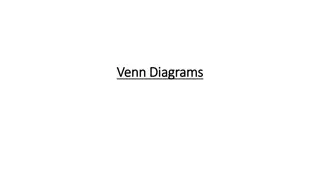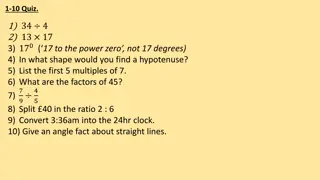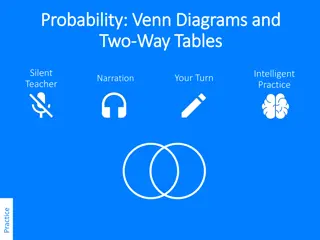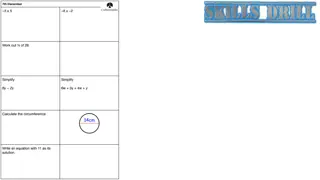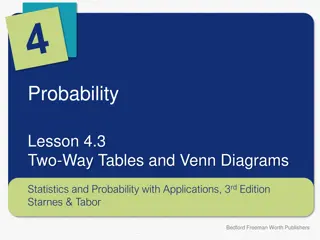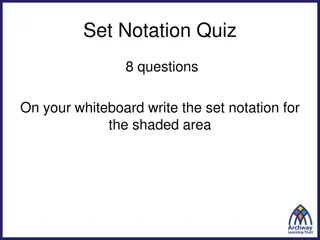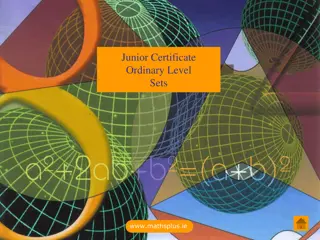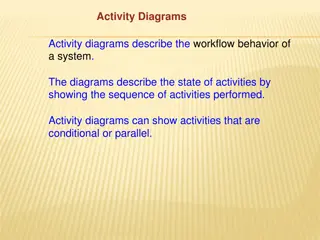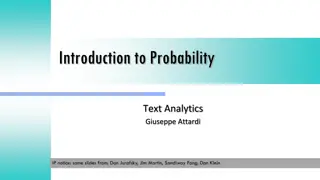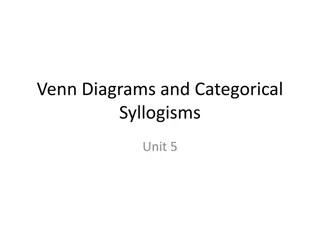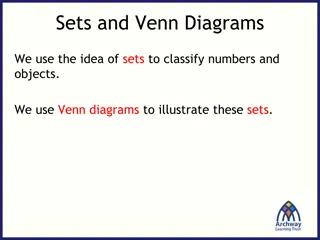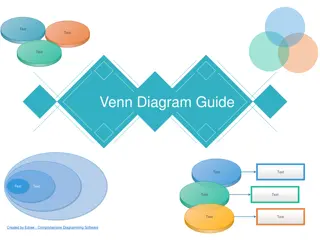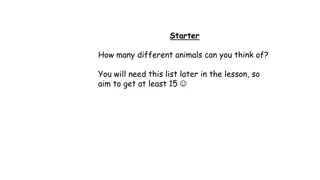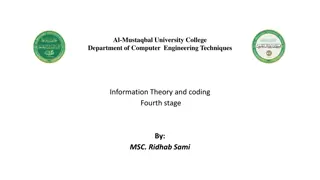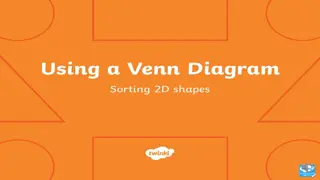Understanding Probability through Venn Diagrams in Practice Questions
Explore various practice questions related to probability using Venn diagrams. From shading regions to calculating probabilities of events, these questions provide a visual and conceptual understanding of probability theory. Topics include intersections, unions, complements, and more.
Download Presentation

Please find below an Image/Link to download the presentation.
The content on the website is provided AS IS for your information and personal use only. It may not be sold, licensed, or shared on other websites without obtaining consent from the author. Download presentation by click this link. If you encounter any issues during the download, it is possible that the publisher has removed the file from their server.
E N D
Presentation Transcript
CHAPTER 19 Probability II Solutions: Practice Questions 19.4
19 Practice Questions 19.4 1. On separate Venn diagrams of events A and B, shade the regions that represent the following: P(A) (i) P(A) P(B) (ii) P(B)
19 Practice Questions 19.4 1. On separate Venn diagrams of events A and B, shade the regions that represent the following: P(A or B) (iii) P(A or B) P(A and B) (iv) P(A and B)
19 Practice Questions 19.4 1. On separate Venn diagrams of events A and B, shade the regions that represent the following: P(not A) (v) P(not A) P(B only) (vi) P(B only)
19 Practice Questions 19.4 2. In a class of 30 students, 25 passed their Christmas Maths exam, 24 passed their Irish exam and 23 passed both exams. Draw a Venn diagram to represent this information and use it to calculate the probability that a student chosen at random: 30 students 25 passed Maths, 24 passed Irish 23 passed both. Only Maths = 25 both = 25 23 = 2 Only Irish = 24 both = 24 23 = 1
19 Practice Questions 19.4 2. In a class of 30 students, 25 passed their Christmas Maths exam, 24 passed their Irish exam and 23 passed both exams. Draw a Venn diagram to represent this information and use it to calculate the probability that a student chosen at random: Neither Irish Maths Total (Maths + Irish + both) 23 1 2 = 30 (2 + 1 + 23) = 30 26 4 = 4
19 Practice Questions 19.4 2. In a class of 30 students, 25 passed their Christmas Maths exam, 24 passed their Irish exam and 23 passed both exams. Draw a Venn diagram to represent this information and use it to calculate the probability that a student chosen at random: didn t pass maths (i) Irish Irish Maths Maths + 1 4 30 5 30 1 6 P(not Maths) = 23 23 1 1 2 2 = 4 4 =
19 Practice Questions 19.4 2. In a class of 30 students, 25 passed their Christmas Maths exam, 24 passed their Irish exam and 23 passed both exams. Draw a Venn diagram to represent this information and use it to calculate the probability that a student chosen at random: passed maths or Irish but not both (ii) Irish Irish Maths Maths P (Maths only) or P (Irish only) 2 1 30 30 3 30 23 23 1 1 2 2 = + = 4 4 1 = 10
19 Practice Questions 19.4 2. In a class of 30 students, 25 passed their Christmas Maths exam, 24 passed their Irish exam and 23 passed both exams. Draw a Venn diagram to represent this information and use it to calculate the probability that a student chosen at random: passed both exams (iii) Irish Irish Maths Maths P(both) 23 23 1 1 2 2 =23 20 4 4
19 Practice Questions 19.4 2. In a class of 30 students, 25 passed their Christmas Maths exam, 24 passed their Irish exam and 23 passed both exams. Draw a Venn diagram to represent this information and use it to calculate the probability that a student chosen at random: passed maths only (iv) Irish Irish Maths Maths P(Maths only) 23 23 1 1 2 2 =2 30 4 4 =1 15
19 Practice Questions 19.4 2. In a class of 30 students, 25 passed their Christmas Maths exam, 24 passed their Irish exam and 23 passed both exams. Draw a Venn diagram to represent this information and use it to calculate the probability that a student chosen at random: didn t pass either exam. (v) Irish Irish Maths Maths P(Neither) 23 23 1 1 2 2 =4 30 4 4 =2 15
19 Practice Questions 19.4 3. Twenty-six people were surveyed about their choice of mobile phones. The survey finds that 14 people have Apple iPhones, 10 have Samsungs and five have Nokias. Four have Apple iPhones and Samsungs, three have Apple iPhones and Nokias and one has a Samsung and a Nokia. No one has all three types of phone. Represent this information on a Venn diagram and use it to calculate the probability that a person chosen at random has: 26 people 14 iPhones, 10 Samsungs, 5 Nokias 4 iPhones + Samsungs, 3 iPhones + Nokia, 1 Samsung + Nokia, 0 All 3. iPhone only 14 (4 + 3) = 14 7 = 7
19 Practice Questions 19.4 3. Twenty-six people were surveyed about their choice of mobile phones. The survey finds that 14 people have Apple iPhones, 10 have Samsungs and five have Nokias. Four have Apple iPhones and Samsungs, three have Apple iPhones and Nokias and one has a Samsung and a Nokia. No one has all three types of phone. Represent this information on a Venn diagram and use it to calculate the probability that a person chosen at random has: 26 people 14 iPhones, 10 Samsungs, 5 Nokias 4 iPhones + Samsungs, 3 iPhones + Nokia, 1 Samsung + Nokia, 0 All 3. Samsung only 10 (4 + 1) = 10 5 = 5
19 Practice Questions 19.4 3. Twenty-six people were surveyed about their choice of mobile phones. The survey finds that 14 people have Apple iPhones, 10 have Samsungs and five have Nokias. Four have Apple iPhones and Samsungs, three have Apple iPhones and Nokias and one has a Samsung and a Nokia. No one has all three types of phone. Represent this information on a Venn diagram and use it to calculate the probability that a person chosen at random has: 26 people 14 iPhones, 10 Samsungs, 5 Nokias 4 iPhones + Samsungs, 3 iPhones + Nokia, 1 Samsung + Nokia, 0 All 3. Nokia only 5 (1 + 3) = 5 4 = 1
19 Practice Questions 19.4 3. Twenty-six people were surveyed about their choice of mobile phones. The survey finds that 14 people have Apple iPhones, 10 have Samsungs and five have Nokias. Four have Apple iPhones and Samsungs, three have Apple iPhones and Nokias and one has a Samsung and a Nokia. No one has all three types of phone. Represent this information on a Venn diagram and use it to calculate the probability that a person chosen at random has: 26 people 7 iPhone only, 5 Samsung only, 1 Nokia only 4 iPhones + Samsungs, 3 iPhones + Nokia, 1 Samsung + Nokia, 0 All 3. None 26 (7 + 5 + 1 + 4 + 3 + 1) = 26 21 = 5
19 Practice Questions 19.4 3. Twenty-six people were surveyed about their choice of mobile phones. The survey finds that 14 people have Apple iPhones, 10 have Samsungs and five have Nokias. Four have Apple iPhones and Samsungs, three have Apple iPhones and Nokias and one has a Samsung and a Nokia. No one has all three types of phone. Represent this information on a Venn diagram and use it to calculate the probability that a person chosen at random has: an iPhone (i) + + 7 3 4 26 = P(iPhone) 14 26 = =7 13
19 Practice Questions 19.4 3. Use the Venn diagram to calculate the probability that a person chosen at random has: a Samsung or a Nokia (ii) P (Samsung or Nokia) + + + + 5 1 1 3 4 26 14 26 = = 7 = 13
19 Practice Questions 19.4 3. Use the Venn diagram to calculate the probability that a person chosen at random has: two phones (iii) P (Two phones) = P (i Phone + Samsung) or P(i Phone + Nokia) or P (Samsung + Nokia) + + 4 3 1 26 8 26 4 13 = = =
19 Practice Questions 19.4 3. Use the Venn diagram to calculate the probability that a person chosen at random has: no phone (iv) P(no phone)=5 26
19 Practice Questions 19.4 3. Use the Venn diagram to calculate the probability that a person chosen at random has: No iPhone (v) P(no iPhone) =5+1+1+5 26 =12 26 =6 13
19 Practice Questions 19.4 4. A group of 20 people are waiting at a bus stop one morning. Nine of them have an umbrella, six have a raincoat and three have both an umbrella and a raincoat. Represent this information on a Venn diagram and use it to calculate the probability that a person chosen at random has: 20 people: 9 Umbrella, 6 raincoat, 3 both. Umbrella only = 9 3 = 6 Raincoat only = 6 3 = 3
19 Practice Questions 19.4 4. A group of 20 people are waiting at a bus stop one morning. Nine of them have an umbrella, six have a raincoat and three have both an umbrella and a raincoat. Represent this information on a Venn diagram and use it to calculate the probability that a person chosen at random has: 20 people: 6 Umbrella only , 3 raincoat only, 3 both. None Coat Umbrella 20 (6 + 3 + 3) 3 3 6 = 20 12 =8 8
19 Practice Questions 19.4 4. A group of 20 people are waiting at a bus stop one morning. Nine of them have an umbrella, six have a raincoat and three have both an umbrella and a raincoat. Represent this information on a Venn diagram and use it to calculate the probability that a person chosen at random has: an umbrella (i) Coat Umbrella P(Umbrella) =9 20 3 3 6 8
19 Practice Questions 19.4 4. A group of 20 people are waiting at a bus stop one morning. Nine of them have an umbrella, six have a raincoat and three have both an umbrella and a raincoat. Represent this information on a Venn diagram and use it to calculate the probability that a person chosen at random has: an umbrella and a raincoat (ii) Coat Umbrella P(Umbrella and Raincoat) =3 20 3 3 6 8
19 Practice Questions 19.4 4. A group of 20 people are waiting at a bus stop one morning. Nine of them have an umbrella, six have a raincoat and three have both an umbrella and a raincoat. Represent this information on a Venn diagram and use it to calculate the probability that a person chosen at random has: an umbrella or a raincoat (iii) P(Umbrella or Raincoat) = P(Umbrella) + P(Raincoat) P(Umbrella and Raincoat) Coat Umbrella 9 20 12 20 3 5 6 20 3 20 = + 3 3 6 = = 8
19 Practice Questions 19.4 4. A group of 20 people are waiting at a bus stop one morning. Nine of them have an umbrella, six have a raincoat and three have both an umbrella and a raincoat. Represent this information on a Venn diagram and use it to calculate the probability that a person chosen at random has: neither. (iv) Coat Umbrella P(neither) =8 20 3 3 6 =2 5 8
19 Practice Questions 19.4 5. A group of students were asked if they preferred soccer, rugby or Gaelic football. The results are shown on the Venn diagram. Calculate the probability that a randomly chosen students likes: soccer or rugby (i) Total: 7 + 14 + 12 + 9 + 15 + 6 + 20 + 19 = 102 P (Soccer) or P (Rugby) = Rugby + Soccer + + + + + 12 14 15 6 7 9 102 63 102 21 34 = = =
19 Practice Questions 19.4 5. A group of students were asked if they preferred soccer, rugby or Gaelic football. The results are shown on the Venn diagram. Calculate the probability that a randomly chosen students likes: rugby or Gaelic football (ii) P (Rugby) or P (Gaelic) = Rugby + Gaelic + + + + + 12 14 15 6 9 20 102 76 102 = = 38 51 =
19 Practice Questions 19.4 5. A group of students were asked if they preferred soccer, rugby or Gaelic football. The results are shown on the Venn diagram. Calculate the probability that a randomly chosen students likes: soccer and Gaelic football but not rugby (iii) P(Soccer and Gaelic but not Rugby) =7+9+20 102 =36 102 =6 17
19 Practice Questions 19.4 5. A group of students were asked if they preferred soccer, rugby or Gaelic football. The results are shown on the Venn diagram. Calculate the probability that a randomly chosen students likes: only Gaelic football (iv) P(Only Gaelic) =20 102 =10 51
19 Practice Questions 19.4 5. A group of students were asked if they preferred soccer, rugby or Gaelic football. The results are shown on the Venn diagram. Calculate the probability that a randomly chosen students likes: none of these sports. (v) P(None) =19 102
19 Practice Questions 19.4 6. Two events A and B have the following probabilities: P(A) = 0 4 P(B) = 0 6 P(A B) = 0 2 Draw a Venn diagram to represent these probabilities and use it to calculate: P(A\B) = 0 4 0 2 P(B\A) = 0 6 0 2 = 0 4 = 0 2
19 Practice Questions 19.4 6. Two events A and B have the following probabilities: P(A) = 0 4 P(B) = 0 6 P(A B) = 0 2 Draw a Venn diagram to represent these probabilities and use it to calculate: P(A B) (i) P(A B) = P(A) + P(B) P(A B) = 0 6 + 0 4 0 2 = 0 8
19 Practice Questions 19.4 6. Two events A and B have the following probabilities: P(A) = 0 4 P(B) = 0 6 P(A B) = 0 2 Draw a Venn diagram to represent these probabilities and use it to calculate: P(A B) (ii) P(A B) = 0 2
19 Practice Questions 19.4 7. Let A and B be independent events, where P(A) = 0 4 and P(B) = 0 7. Find P(A B) (i) = P(A and B) P(A B) = P(A) P(B) = 0 4 0 7 = 0 28
19 Practice Questions 19.4 7. Let A and B be independent events, where P(A) = 0 4 and P(B) = 0 7. Find P(A B) (ii) P(A B) = P(A) + P(B) P(A B) = 0 4 + 0 7 0 28 = 0 82
19 Practice Questions 19.4 7. Let A and B be independent events, where P(A) = 0 4 and P(B) = 0 7. Draw a Venn diagram and shade the region that represents A B (iii) A B = A\B
19 Practice Questions 19.4 7. Let A and B be independent events, where P(A) = 0 4 and P(B) = 0 7. Find P(A B ) (iv) P(A B ) = P(A/B) = P(A only) = 0 4 0 28 = 0 12
19 Practice Questions 19.4 8. A driving test consists of a practical test and theory test. One day everyone who took the test passed at least one section. 64% passed the practical section and 78% passed the theory section. 64% Practical (Pr) 78% Theory (T) 64 + 78 = 142% Pr T = 142% 100% = 42%
19 Practice Questions 19.4 8. A driving test consists of a practical test and theory test. One day everyone who took the test passed at least one section. 64% passed the practical section and 78% passed the theory section. Represent this information on a Venn diagram showing the probabilities of candidates in each section of the diagram. (i) 64% Practical (Pr) 78% Theory (T) Pr only = 64 42 64 + 78 = 142% = 22% Pr T = 142% 100% T only = 78 42 = 42% = 36% T Pr 42% 22% 36%
19 Practice Questions 19.4 8. A driving test consists of a practical test and theory test. One day everyone who took the test passed at least one section. 64% passed the practical section and 78% passed the theory section. One person is chosen at random from all the people who took the test that day. What is the probability that this person: 64% Practical (Pr) 78% Theory (T) 64 + 78 = 142% passed the practical section and the theory section? (ii) Pr T = 142% 100% = 42% P(Theory and Practical) = 42% (both = Pr T) T Pr 42% 22% 36%
19 Practice Questions 19.4 8. A driving test consists of a practical test and theory test. One day everyone who took the test passed at least one section. 64% passed the practical section and 78% passed the theory section. One person is chosen at random from all the people who took the test that day. What is the probability that this person: 64% Practical (Pr) 78% Theory (T) 64 + 78 = 142% (iii) passed the theory section only? Pr T = 142% 100% P(Theory only) = 36% = 42% Pr T 42% 22% 36%



